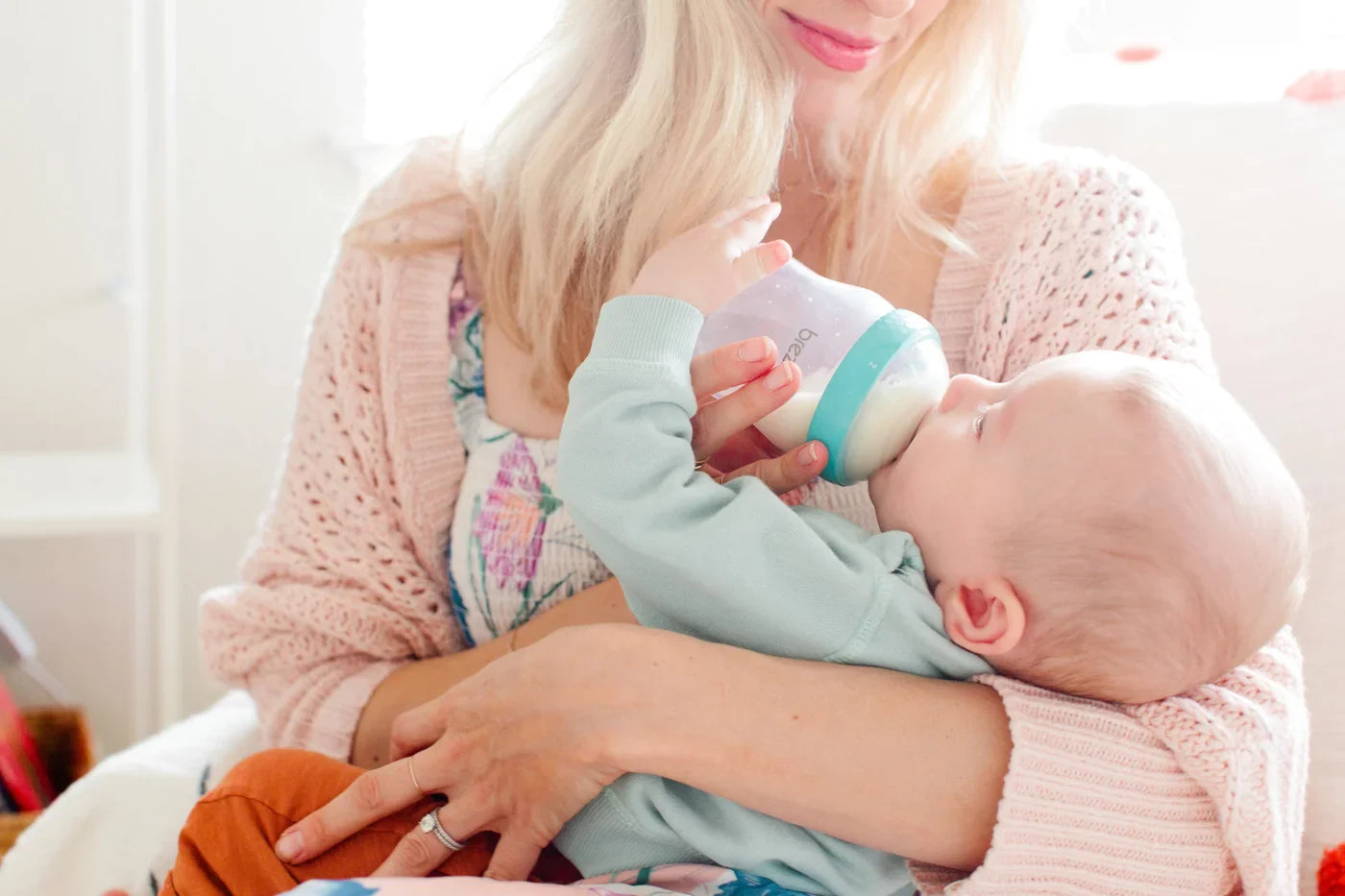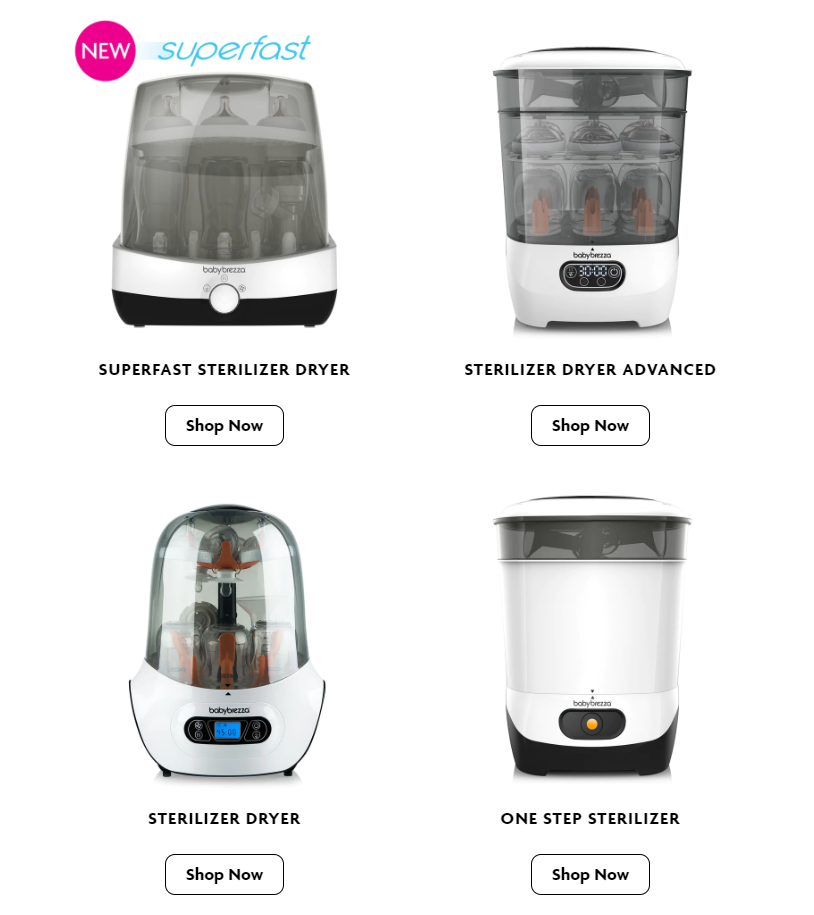New parents may be afraid of making a baby blunder – mixing formula wrong, not burping baby properly, forgetting the words to ‘Twinkle, Twinkle, Little Star’ or any one of a host of other problems that can come from sleep deprivation and inexperience.
But here’s a mistake you may not even realize you were making: skipping baby bottle sterilization.
You might have thought soapy water or a run through the dishwasher was enough to call the bottle squeaky clean. You may be asking yourself “Do you have to sterilize baby bottles?”, “Who really needs a bottle sterilizer and dryer to add to the collection of baby apparatus and appliances?”
You do – and every parent with a bottle-fed baby.
And here’s why.
Why Sterilize Baby Bottles
Sterilizing baby bottles is an important part of infant feeding hygiene, particularly in the early months when your baby’s immune system is immature and more vulnerable to infection.
Even with careful washing, bottles and nipples can harbor harmful microorganisms- including E. coli, Salmonella, and Listeria- which thrive in the warm, moist environment left by milk or formula residue. Sterilization uses high heat (via steam, boiling, or other methods) to kill 99.9% of bacteria, viruses, and fungi that may remain after cleaning.
Here’s why it matters:
- Immature immune systems. Newborns, especially those under 3 months old, don’t yet produce enough antibodies to fight off common pathogens. According to the World Health Organization (WHO), extra care should be taken when preparing and handling feeding equipment for infants to reduce the risk of foodborne illness.¹
- Formula-fed babies are at higher risk. Unlike breast milk, infant formula doesn’t contain immune-protective factors (like antibodies and enzymes), making proper sterilization of bottles even more important for these infants.²
-
Environmental bacteria are everywhere. Bottles can pick up microbes from countertops, sinks, or improperly dried cloths- even if they look clean. Sterilization ensures any lingering germs are eliminated before each use.
While sterilizing isn’t always necessary after every single feed once your baby is older and healthy, it is strongly recommended during the first 3 months, and for preterm infants or babies with weakened immune systems. It’s also a smart practice when traveling, during illness, or if you don’t have access to consistently clean water for washing.
What Illnesses Can Sterilizing Help Prevent?
Sterilizing baby bottles can significantly reduce your baby’s risk of developing infections, particularly those that affect the digestive and immune systems. Harmful bacteria and viruses can linger on improperly cleaned feeding equipment and be transferred directly into your baby’s body during feeding.
Some of the most common illnesses that sterilization helps protect against include:
- Gastroenteritis - An intestinal infection that causes vomiting, diarrhea, fever, and dehydration. Often caused by bacteria like E. coli, Salmonella, or viruses such as rotavirus.
- Thrush (oral candidiasis) - A yeast infection in the mouth caused by Candida albicans. It can spread through bottle nipples and pacifiers if not properly sterilized.
- Respiratory infections - Inhaling bacteria from contaminated bottles can contribute to conditions like pneumonia or bronchitis, especially in very young infants.
-
Listeriosis - A rare but serious infection caused by Listeria monocytogenes, which can be transmitted through contaminated milk or formula.
Because babies’ immune systems are still developing, especially in the first few months, they’re less able to fight off these infections. Sterilizing bottles is a simple but powerful step to help keep your baby safe and healthy.
How Long to Sterilize Baby Bottles
For most babies, it’s recommended to sterilize bottles regularly until around 3 months of age. During this early stage, your baby’s immune system is still developing, making them more vulnerable to harmful bacteria, viruses, and other pathogens that can linger on feeding equipment, even after thorough washing.
According to the Centers for Disease Control and Prevention (CDC) and the World Health Organization (WHO):
- For babies under 3 months old, as well as premature babies or those with weakened immune systems, daily sterilization of bottles, nipples, and pump parts is strongly recommended.
-
After 3 months, if your baby is healthy and full-term, regular washing with hot soapy water or a dishwasher (with a heated drying cycle) is generally considered sufficient. Many parents still choose to sterilize occasionally for added peace of mind, especially during illness, travel, or exposure to less-than-ideal cleaning conditions.
Ultimately, how long you continue sterilizing comes down to your baby’s health, your environment, and your personal comfort level. When in doubt, consult your pediatrician, especially if your baby was born early or has specific health concerns.
HOW OFTEN SHOULD I STERILIZE BABY BOTTLES?
For proper germ and bacteria removal, it is recommended to sanitize feeding items at least once daily. Sanitizing baby bottles consistently is particularly important when your baby is younger than 2 months, was born prematurely, or has a weakened immune system. Investing in a sterilizer you will use daily will save parent’s time and give them complete peace of mind.
How to Store Sterilized Bottles
Sterilizing baby bottles is only half the battle; how you store them matters just as much. Improper storage can quickly undo your efforts by exposing clean bottles to dust, bacteria, and other contaminants.
Best Practices for Storing Sterilized Bottles:
- Keep bottles dry and covered. Moisture invites bacteria, so always allow bottles to dry fully before storing. Use a clean lid, cap, or cover to keep dust and germs out.
- Avoid using a dish towel to dry. Towels can carry bacteria. Instead, let bottles air dry on a clean surface or inside a sterilizer with a drying function.
-
Store in a clean, closed container. Use a clean, food-safe container or storage bin with a lid. Avoid leaving bottles exposed on countertops or in drawers.
Bonus Tip: Store Them Right in Your Sterilizer
If you're using the Baby Brezza Sterilizer & Dryer, you’re already a step ahead. One of its biggest perks is that it keeps bottles sterile for up to 24 hours, as long as the lid remains closed. That means you can sterilize, dry, and store in one place, with no need to transfer items or worry about recontamination.
It’s an easy way to keep your feeding gear organized, hygienic, and ready to go- especially during those hectic newborn days.
USING A BOTTLE STERILIZER VERSUS OTHER METHODS OF STERILIZATION
If you’re convinced of the importance of bottle sterilization, you may be wondering how to sterilize baby bottles.
There are a number of methods of sterilizing a baby bottle, though many parents find it most convenient to use a small appliance known as a baby bottle sterilizer to get the task done thoroughly and efficiently.
HERE ARE SOME OF THE MOST COMMON WAYS TO STERILIZE BABY BOTTLES:
There are a few common ways to sterilize baby bottles, each with its own pros and drawbacks. Here's a breakdown to help you decide what works best for your routine:
Microwave Method
Some parents use the microwave by filling bottles halfway with water and placing nipples and rings in a separate bowl of water, then heating everything for about 90 seconds. It’s a quick solution, but only if you have a microwave and feel comfortable microwaving plastic. Just make sure your bottles are BPA-free and labeled microwave-safe to avoid chemical leaching or damage.
Cold Water Sterilizing Tablets
This method involves dissolving sterilizing tablets in cold water and submerging bottles, nipples, and accessories for at least 30 minutes. While useful when you don’t have access to heat, it can be a bit of a hassle; you’ll need to remember to stock the tablets and rinse everything with cooled, boiled water afterward to remove chemical residue before feeding.
Boiling
Boiling bottles is a reliable, low-cost method. You’ll need a large pot reserved just for sterilizing, filled with enough water to fully submerge the bottles and parts. Bring it to a boil, cover with a lid, and let everything sterilize for 10 minutes. Don’t remove the lid until you’re ready to use the items to keep them sterile. Be sure to inspect bottles and nipples regularly for heat damage, especially if using this method frequently.
Steam Bottle Sterilizer
A steam sterilizer is the go-to for many parents, and for good reason. It’s fast, chemical-free, and incredibly convenient. Steam sterilizers use natural steam to kill up to 99.9% of germs without soap or chemicals.
Take the Baby Brezza One-Step Sterilizer & Dryer: it sterilizes up to six bottles in just 8 minutes, then automatically dries everything with your choice of a 30, 45, or 60-minute cycle. It works on more than just bottles- pacifiers, breast pump parts, and teething toys can go in too. And with its built-in drying function, you can skip the drying rack (a known breeding ground for bacteria), helping to keep your bottles cleaner, longer.
If you’re sterilizing bottles daily, as recommended in those early months, an all-in-one machine like this can save you time and give you peace of mind, so you can focus on what really matters: spending more time with your baby.
Do You Need a Bottle Sterilizer?
Technically, no, you don’t need a bottle sterilizer to keep your baby safe. But if you’re looking for the best way to sterilize baby bottles quickly, effectively, and with minimal effort, a bottle sterilizer is hard to beat.
You can sterilize bottles using boiling water, microwave steam bags, or chemical tablets, but each of these methods has its drawbacks. A bottle sterilizer, especially one with an integrated drying function, offers the most convenient, reliable, and hygienic solution. It uses steam to eliminate 99.9% of bacteria and keeps bottles sterile for up to 24 hours when the lid stays closed.
Take the Baby Brezza Sterilizer & Dryer, for example. It sterilizes and dries bottles in a single step, so you don’t have to worry about transferring wet bottles to a drying rack (which can introduce bacteria). It’s hands-off, fast, and perfect for daily use, especially in those early months when you’re sterilizing bottles often.
So, while a bottle sterilizer isn’t strictly necessary, it might be one of the best time-saving tools you invest in, making your feeding routine easier, safer, and less stressful.
Sources:
-
WHO – Guidelines on the safe preparation, storage and handling of powdered infant formula
https://www.who.int/publications/i/item/9789241595414 -
Infant Risk Center - Antibodies, the Immune System, & Breastfeeding: The Basics https://www.infantrisk.com/content/antibodies-immune-system-breastfeeding-basics


